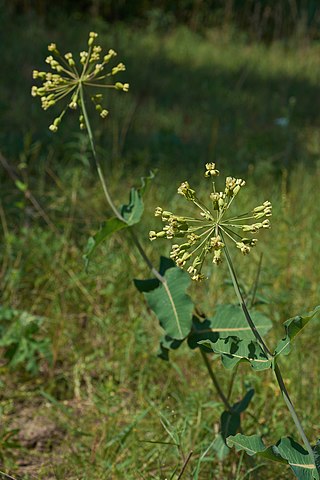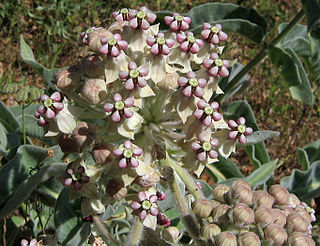
Asclepias is a genus of herbaceous, perennial, flowering plants known as milkweeds, named for their latex, a milky substance containing cardiac glycosides termed cardenolides, exuded where cells are damaged. Most species are toxic to humans and many other species, primarily due to the presence of cardenolides. However, as with many such plants, some species feed upon them or from them. The most notable of them is the monarch butterfly, which uses and requires certain milkweeds as host plants for their larvae.

Asclepias purpurascens, the purple milkweed, is a herbaceous plant species. It is in the genus Asclepias, making it a type of milkweed. It is native to the Eastern, Southern and Midwestern United States similar to the range of the common milkweed. The plant gets its name from the flowers that first develop a pink color but then turn darker purple as they mature. Unlike common milkweed, purple milkweed prefers some shade and is considered a plant of partial shade. It is also considered an indicator of oak savanna, especially in Wisconsin. The species rarely produces seed pods which are smooth, instead of the rough warty ones produced by common milkweed.

Asclepias verticillata, the whorled milkweed, eastern whorled milkweed, or horsetail milkweed, is a species of milkweed native to most of eastern North America and parts of western Canada and the United States.

Asclepias amplexicaulis, the blunt-leaved milkweed, clasping milkweed, or sand milkweed, is a species of flowering plant in the subfamily Asclepiadoideae (Apocynaceae). It is endemic to the United States, where it is mostly found east of the Great Plains. It grows in dry prairies, savannas, open woods, and fallow fields, usually in sandy soil.

Asclepias eriocarpa is a species of milkweed known by the common names woollypod milkweed, Indian milkweed, and kotolo. It is a perennial herb that grows in many types of habitats.

Asclepias meadii is a rare species of milkweed known by the common name Mead's milkweed. It is native to the American Midwest, where it was probably once quite widespread in the tallgrass prairie. Today much of the Midwest has been fragmented and claimed for agriculture, and the remaining prairie habitat is degraded.

Veronica bullii is a species of flowering plant in the plantain family known by the common names kittentails and Bull's coraldrops. It is native to the Upper Midwest of the United States, including the states of Ohio, Indiana, Illinois, Wisconsin, Iowa, and Minnesota.

Asclepias quadrifolia, commonly called four-leaved milkweed or fourleaf milkweed, is a species of milkweed in the Apocynaceae (dogbane) family. It is sometimes referred to as whorled milkweed, but it should not be confused with Asclepias verticillata. A. quadrifolia occurs in the eastern United States and Canada.

Asclepias lanceolata, the fewflower milkweed, is a species of milkweed that is native to the coastal plain of the United States from New Jersey to Florida and Southeast Texas. A. lanceolata is an upright, perennial plant that can grow between 3 and 5 feet tall, with red-orange flowers blooming in the summer months. It can also be referred to as Cedar Hill milkweed, as it was first described by Dr. Eli Ives in the neighborhood of Cedar Hill in New Haven, Connecticut.

Asclepias sullivantii is a species of flowering plant in the milkweed genus, Asclepias. Common names include prairie milkweed, Sullivant's milkweed, and smooth milkweed. It is native to North America, where it occurs in the central United States and Ontario in Canada.

Asclepias curtissii, or Curtiss's milkweed, is a rare species of flowering milkweed that is endemic to Florida's sandy areas. Curtiss's milkweed belongs to the subfamily Asclepiadoideae and the genus Asclepias. This dicotyledonous, perennial plant was placed on the endangered species list by the state of Florida to protect this rare milkweed. Although Curtiss milkweed is found all over Florida, the populations are very isolated and concentrated.

Asclepias viridiflora, is commonly known as green comet milkweed, green-flower milkweed, and green milkweed. It is a widely distributed species of milkweed (Asclepias), known from much of the eastern and central United States from Connecticut to Georgia to Arizona to Montana, as well as southern Canada. The Latin specific epithet viridiflora means green-flowered.

Desmodium illinoense, the Illinois ticktrefoil, is a flowering plant in the bean family (Fabaceae), native to the central United States and Ontario, Canada. Illinois ticktrefoil grows in sunny places, such as prairies and oak savannas of the Great Plains and Great Lakes regions.

Asclepias hirtella, commonly called the tall green milkweed, is a species of flowering plant in the milkweed genus and dogbane family (Apocynaceae). It is native to Canada and the United States, where its range is concentrated in the Midwest and Upper South.

Boechera retrofracta is a species of flowering plant in family Brassicaceae. The common names include reflexed rockcress.

Bartonia virginica is species of flowering plant in Gentianaceae. It is the commonly called yellow screwstem or yellow bartonia and it is an annual species with small pale green to yellow flowers.

Asclepias angustifolia, commonly called the Arizona milkweed, is an endemic species of milkweed native only to Arizona.

Asclepias perennis, also known as aquatic milkweed or white swamp milkweed, is a North American species of milkweed that is found throughout the Coastal Plain from eastern Texas to southern South Carolina, northward along the Mississippi River, and into the Ohio Valley of Illinois, Indiana, and Kentucky. There seems to be a few disjunct populations in Arkansas, Texas, and Indiana.



















